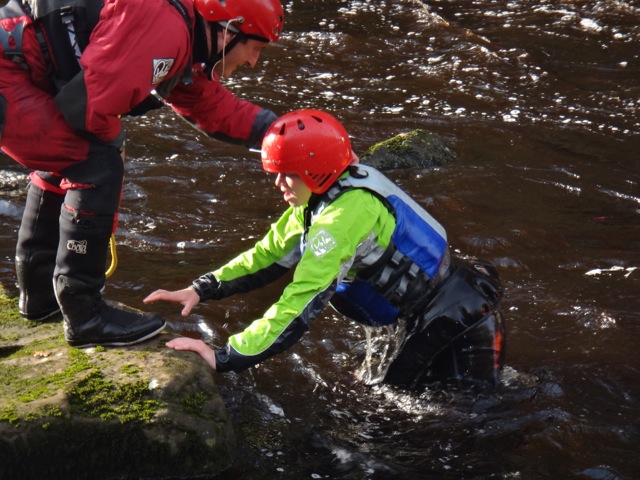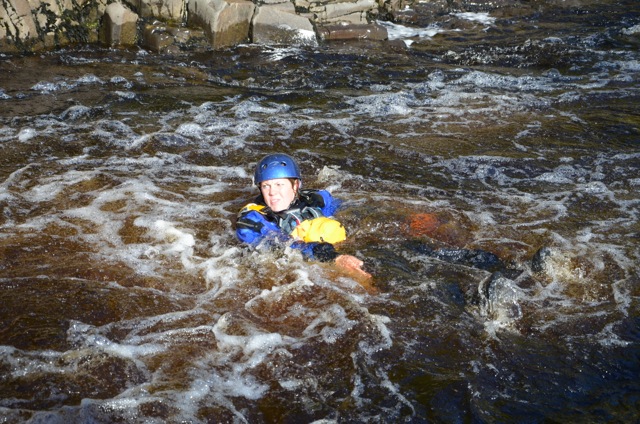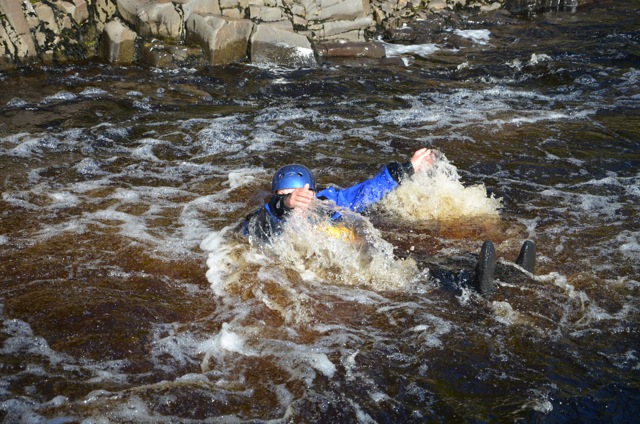With the Tyne Tour coming up very shortly I thought it might be a good idea to release the next article in the student guide series. Although a student guide it is applicable to anyone who may be starting to make the move onto moving water.
From time to time this will happen and is far more common than even the great boaters like to admit. Capsizing and swimming is what helps us all get better, it’s part of the learning curve no matter what level of the sport you are currently at.
There are two main goals if you find yourself in the water. The first is to stay safe whilst in the water and second is to get out of the water.
Hopefully you have had some practice at doing capsize drills in a controlled environment in the past, if not it is a great idea that you get some practice in.
Assuming that you have capsized and then bailed from the boat you need to be thinking ahead and staying calm. When you first pop back up to the surface have a quick scan around whilst you get yourself into a defence swimming position. The ideal setup for the defensive swimming position is to float on your back and to have your legs pointing down stream. This will allow you to use your legs to defend yourself against obstacles in the water. You may get lucky and pop up next to someone who can help you out. If you do, follow their directions and do not try to climb up on their boat.
If you find yourself floating by yourself try and stay calm. Keep your mouth shut so you don’t take on any water. If you can keep hold of your kit then great, but if this means getting yourself into a more dangerous situation then let go of your boat/paddle. As you swim defensively use your arms and feet as necessary to avoid hazards.
When you are in the water it may be possible that you will hear someone shout ROPE. This means that a throwbag full of rope is heading your way. If the person throwing is on target and setup correctly you should find (once you have hold of the rope) that you will swing to the side of the river. Try and stay in the defensive swimming position whilst you have hold of the rope as this is still the safest setup whilst you are in the water. Don’t try and wrap the rope around you or tie yourself to it.
Assuming none of the above is likely then it’s time to self rescue. Look out for an eddy (area of slack water) at the side of the river. Keeping the defensive swimming position use your arms and legs to safely move yourself closer to the side.
As you come close to the eddy line (a distinct line between the moving river and slack water) move into a normal front crawl position and swim like hell. Keep swimming until you are in the calmer water before attempting to stand up.






Nice post mate, one thing I see alot is swimmers standing up before they get to the bank – this leaves them open to foot entrapment hazards. Its intuitive to stand up but also very risky in moving water. Worth reminding them of this
You’ve missed the most important part of swimming a rapid, DON’T STAND UP, ever.
Very true. If you are swimming defensively as I have recommended you won’t be standing up until you are in the slack water. In some cases this could be mid rapid.
But also worth mentioning is that if you are inevitably headed for a strainer (downed tree or otherwise), get in the normal front crawl position ASAP and CHARGE THE STRAINER. As you reach the strainer, do EVERYTHING you can to get as high up as possible. As you reach your arm from your crawl stroke and touch the wood/strainer, immediately get your other arm there too and try like a pushup type move. Don’t stop there, keep grabbing for whatever you can to get UP and OUT of the water.
I highly recommend taking a swiftwater rescue course, as you will get to practice this technique in a safe environment. If you are just beginning to get into whitewater, ALWAYS go with experienced people, and ask questions/get answers. Whitewater is one of the most rewarding sports/hobbies out there, but don’t put yourself in any situation that you think is likely to end your life. Be safe!!
Good points, many thanks.
Similarly to strainers point above…
Are there any known dangerous/deadly features downstream? If so, dont wait till you get there – a few bruises on your belly from exposure to stones as you put everything you have to swim frontcrawl for an eddy/bank is an infinitely better option than what may wait downstream.
Whitewater is not uniform! It does not know about guides and recommendations. Use your own brain – it is your life at stake. Try to guess whats happening under surface. If you are nearing an eddy line, it is generally deep/safe enough to turn around and make a few strong strokes to insure you make it, as opposed to waiting for the next one..
100% passive/defensive strategies imo are almost always inferior – as the video in the previous post shows well. Defend but pick your moment to make it to safety.
Deciding on the best eddies to swim into downstream (may not be the same as the ones to paddle into!) before you attempt the rapid will make your life much easier.